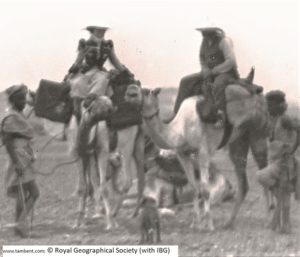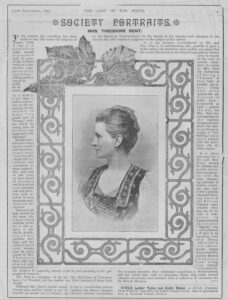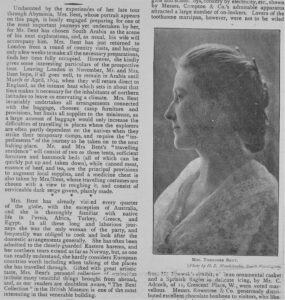
Following their work at Great Zimbabwe in 1891, the Bents were minor celebrities both in the UK and overseas; 1892 saw the first edition of Theodore’s Ruined Cities of Mashonaland. Barely taking a breath, the couple prepared for a trek to Aksum (Ethiopia) in the early months of 1893, and a monograph soon followed – The Sacred City of the Ethiopians (1893). Bent’s interest in early civilizations to the west of the Red Sea now enticed the two travellers to its east, and into the mysterious and dangerous Wadi Hadramaut (modern Yemen), marking the start of Theodore’s final field of study. In effect, it would kill him.
Brand Bent now went into overdrive in the summer of 1893 – meetings, finance and support were sought, inter alia, from the Royal Geographical Society, Royal Botanic Gardens, Kew, the British Museum, the India/Foreign Office…
The couple had just a few months to put everything in place, including a full programme of self-promotion. Theodore lectured and sent out press releases, Mabel gave a series of interviews to newspapers and periodicals, two appear below, with transcriptions, and they are typical of many!
Interview with Mabel Bent for The Lady of the House* (later the Irish Sketch/Irish Tatler), 15 September 1893

“In the present day travelling has been made so easy that under the auspices of Messrs. Cook & Son it is possible to make oneself acquainted with all parts of the civilised world at a cost which is – comparatively speaking – trifling, and one can go to India, for instance, in a shorter time than it took our ancestors at the beginning of this century to make ‘the grand tour of Europe’, without which no young man of position was supposed to be educated! But all travellers now-a-days are not content with the stereotyped tours ‘personally conducted’ (excellent and convenient as these undoubtedly are), and of late years we have heard of journeys which involved considerable risk and privation, and resulted in most important antiquarian discoveries.
“That an Irish lady should be the most distinguished member of her sex in this respect is distinctly gratifying to our patriotic feelings, and her countrymen and women may be justly proud of Mrs. Theodore Bent, who has shared with her husband all the dangers of exploring remote districts, and in assisting in his geographical research. Mrs. Bent is a daughter of the late Mr. Hall-Dare, of Newtownbarry, Co. Wexford, and her mother was Miss Lambart of Beau Parc, Meath.
“Although Mrs. Bent’s travels usually occupy a considerable portion of each year, and her home is now in England, she always manages time for an annual visit to Ireland; and the lace industry established by her family at Newtownbarry for the benefit of the tenantry and cottages in the vicinity has still a staunch supporter in the subject of this sketch. As to the journeys accomplished by Mr. and Mrs. Bent, it is, unfortunately, only possible to give a brief outline, but doubtless most readers are aware that the recent discussion at the Royal Geographical Society arose by reason of the wish of several members to confer on Mrs. Bent the distinction of being a ‘Fellow’ of that body of notable travellers. Those who were against the admission of ladies have temporarily, at least, gained the day, but Mrs. Bent has not experienced the slightest disappointment about the matter, as she never sought a ‘Fellowship’, and is quite content with the privileges she already enjoys.
It is about nine years since Mr. and Mrs. Bent started for Athens, and made themselves acquainted with the most interesting portions of Greece, returning next year to the Cyclades Isles, and bringing back to the British Museum many valuable relics dug out of the ruins at Antiparos. In Egypt, too, some successful digging was accomplished, and also at an Egyptian town near Thrace**, while at Cilicia this adventurous couple discovered Olba and the famous ‘Korycian Cave’. A long tour through Persia and over the Caucasus preceded their celebrated expedition to Mashonaland, and last winter they went to Abyssinia, where they made several valuable discoveries and returned with a collection of curiosities for the British Museum.” (The Lady of the House (later the Irish Sketch/Irish Tatler), 15 September 1893, p.19)
* “The ‘Lady of the House’, in addition to a variety of literary contributions of merit, has a specially attractive feature in its publication this week… Mrs Theodore Bent is the subject of the ‘Society Portraits’. Mrs Bent is a daughter of the late Mr Hall-Dare of Newtownbarry, Co. Wexford, who was married to Miss Lambart of Beau Park, Co Meath.’ (Dublin Daily Express, Friday 15 September 1893)
(The very popular ladies’ periodical The Lady of the House was published in Ireland, appearing 1880-1924, when it joined with The Irish Tatler and Sketch. It was favoured for its content and production standards, photographs, etc. Although it mainly covered items to do with appearance and being ‘at home’, the newspaper also looked at matters political, economic, and societal. It was the brainchild of the Dublin advertising company Wilson Hartnell, being planned initially as a monthly or bimonthly format for advertising, in particular a marketing forum for Messrs Findlater & Co., a wine merchant and grocer whose clientele were primarily the upper middle class ladies of Dublin. “Although [showcasing] philanthropic, titled ladies in its early years, the readership, as is clear from reader engagement and advertising, were middle- to lower-middle-class women throughout the country who held some purchasing power but who did most or all of their own housework”.)
** Rather an odd reference. The Bents never dug in Egypt (apart from burying the remains of a picnic below the Sphinx in 1885!). Perhaps Mabel is thinking of their work on Thracian Thasos in the late 1880s).
Interview with Mabel Bent, 2 November 1893, in the Irish weekly The Hearth and Home

“Undaunted by the experiences of her late tour through Abyssinia, Mrs. Bent, whose portrait appears on this page, is busily engaged preparing for one of her most important journeys yet undertaken by her, for Mr. Bent has chosen South Arabia as the scene of his next explorations, and, as usual, his wife will accompany him. Mrs. Bent has just returned to London from a round of country visits, and having only a few weeks to make all the necessary preparations finds her time fully occupied. However, she kindly gives some interesting particulars of the prospective tour. Leaving London in November, Mr. and Mrs. Bent hope, if all goes well, to remain in Arabia until March or April, 1894, when they will return direct to England, as the intense heat which sets in about that time makes it necessary for the inhabitants of northern latitudes to leave so enervating a climate. Mrs. Bent invariably undertakes all arrangements connected with the baggage, chooses camp furniture and provisions, but limits all supplies to the minimum, as a large amount of the baggage would only increase the difficulties of travelling in places where the explorers are often partly dependent on the natives when they strike their temporary camps, and require the ‘impedimenta’ of the journey to be taken to the next halting-place. Mr. and Mrs. Bent’s ‘travelling residence’ will consist of two beds or three tents, sufficient furniture and hammock beds (all of which can be quickly put up and taken down), while canned meats, essence of beef, and tea, are the principal provisions to augment local supplies, and a medicine chest is also taken by Mrs. Bent.’ Whose travelling costumes are chosen with a view to roughing it, and consist of serviceable dark serge gowns, plainly made.
“Mrs. Bent has already visited every quarter of the globe, with the exception of Australia and she is thoroughly familiar with native life in Persia, Africa, Turkey, Greece, and Egypt. In all these long and laborious journeys she was the only woman of the party , and frequently was obliged to cook and look after the domestic arrangements generally. She has often been admitted to the closely-guarded Eastern harems, and her northern tours extend as far as Norway,* but, as one can readily understand, she hardly considers European countries worth including when talking of the places she has travelled through. Gifted with great artistic taste, Mrs. Bent’s personal collection of curiosities include many beautiful things brought from abroad, and, as our readers are doubtless aware, ‘The Bent Collection’ in the British Museum is one of the most interesting in that venerable building.” (Interview with Mabel, 2 November 1893, in the Irish weekly The Hearth and Home)
*Mabel writes elsewhere that she met Theodore Bent in Norway.
[You may also enjoy two interviews Mabel gave to Lady of the House in 1893 and 1894] Leave a comment or contact us about this article
Leave a comment or contact us about this article